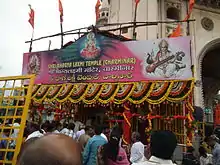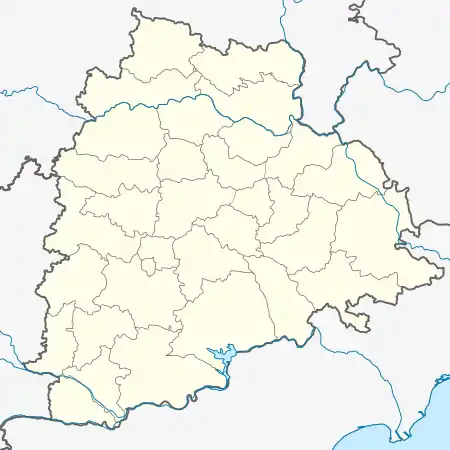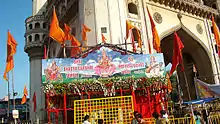Bhagyalakshmi temple
Bhagyalakshmi temple is a Hindu temple located in Hyderabad, India. This temple is located adjacent to the city's historic monument Charminar. Charminar is under care of Archaeological Survey of India (ASI), while a Hindu trust manages the temple dedicated to the Goddess Lakshmi. The origin of the temple is currently disputed and the current structure that houses the idol was erected in the 1960s. ASI has declared the temple structure as an unauthorised construction.[1] Telangana High Court have stopped any further expansion of the temple.[2]
| Bhagyalakshmi | |
|---|---|
 Bhagyalakshmi Temple, Hyderabad | |
| Religion | |
| Affiliation | Hinduism |
| District | Hyderabad |
| Deity | Lakshmi |
| Location | |
| State | Telangana |
| Country | India |
 Location within Telangana
(around 3) | |
| Geographic coordinates | 17°21′41″N 78°28′28″E |
History
.jpg.webp)

In 2012, Times of India reported citing old people that in the late 1960s, the temple building was built on the eastern side of the iconic Charminar and opened for visits by devotees. Times of India referred to the popular folklore that the holy stone was laid at the site several years ago at an unknown date, most likely since the Quli Qutub Shah period. Soon the stone was being idolized as a symbol of prosperity by the residents.[2] Others insist that the temple did not exist there until it was erected few decades back and called the claims of the temple being "as old as the Charminar" as completely 'baseless' claims.[2]
Claims of newer origins of temple are proposed by historians such as Narendra Luther, who maintain that the temple had no existence of any sorts until the 1960s when it was erected un-necessarily by some locals.[2] According to historians, one of the guard stone similar in shape to a milestone near Charminar was painted with saffron color in 1965, and an old woman became the person in-charge of this shrine. After an Andhra Pradesh State Road Transport Corporation bus collided with the stone and damaged it, a pucca structure was created at the site.[3] The stone was replaced with an idol of the goddess Lakshmi.[2] English newspaper The Hindu supports the claim that Temple was built in the 1960s and produced pictures of Charminar taken in the year 1957 and 1962 showing that no temple existed at the said location. A picture taken in 1986 shows the temple structure.[4] In 2012, Archaeological Survey of India in an RTI response categorized the temple structure as an unauthorised construction.[1]
A case was filed in the High court, opposing the encroachment of Charminar by the temple authorities. High court ordered to maintain the status quo and banned any further construction of the temple.[5]
According to the Muslim Priest of Charminar altar, the original stone in question was a guard stone placed near the corner to protect the walls of charminar from automobiles.[6]
Local Congress leader G. Niranjan considers the co-existence of the two structures as a reflection of the "composite culture" of Hyderabad. He claimed that Charminar had places of worship for both communities for several centuries and it was sending a message to the entire world about rich secular traditions and the Ganga-Jamuni tehzeeb ("composite culture") of Hyderabad.[7] A book sources the name of the shrine in the memory of the Queen Bhagmati (or Bhagyavati).[8]
AMASR Act
The "Ancient Monuments and Archaeological Sites and Remains Act" or AMASR Act passed in 1958 is an act of parliament of the government of India that provides for the preservation of ancient and historical monuments and archaeological sites and remains of national importance.[9][10]
The rules stipulate that area in the vicinity of the monument, within 100 meters is prohibited area. The area within 200 meters of the monument is regulated category. Any repair or modifications of buildings in this area requires prior permission.[11] According to the ASI officials, the Bhagya Laxmi temple comes under the prohibited area of the monument Char Minar. Hence any activity that attempts to extend the structure is considered "illegal activity".[11]
Controversies
The temple has been a subject of controversy due to its disputed origins and the "threat" its construction and expansion poses to the protected historic Charminar structure.[11] In the 1960s, the replacement of the holy stone with an idol and the addition of a temporary shed evoked communal tensions.[2]
In 1979, the Majlis-e-Ittehadul Muslimeen (MIM), a political party in India, called a bandh to protest against the encroachment on the mosque in Mecca, Saudi Arabia. When some local Hindu traders requested to keep open their shops due to ongoing Hindu festivities, communal forces desecrated the temple on 23 November 1979, looted the shops and set fire to them.[8]
During the Ganeshotsava celebrations in September 1983, certain Hindu organizations put up big cloth banners at a number of places in the area asking for the declaration of India as a Hindu republic. In this charged atmosphere, a Muslim threw a stone at the temple. Communal forces desecrated a mosque in retaliation and placed idols and pictures of Hindu Gods which resulted in MIM calling for a bandh. The situation soon developed into riots, in which 45 people were killed.[12][13]
During the night of 1 November 2012, the temple administration started to carry out some construction work without the permission of Archaeological Survey of India (ASI), stating that they were decorating the temple ahead of the Diwali festival.[14] The construction activity, which was illegal according to the ASI, was stopped by the police.[11]
The temple authorities maintain that they were not planning an expansion and had only replaced the worn-out bamboo structures with new ones.[2] A contingent of MIM party workers and five MLAs led by Akbaruddin Owaisi organized a rally, alleging that the police were facilitating the illegal expansion work. The police stopped the rally and took the MIM leaders into custody.[15] Following this, a few violent incidents were reported in the city, including stone pelting and damage to four APSRTC buses, two cars, an ATM and a garments showroom.[16] The city administration temporarily put a ban on the public visits to Charminar, shut down the nearby market and barricaded some of the streets.[17] The police also prevented the Hindu leaders from organizing a march to the temple by taking the organizers into custody.[18]
On 16 November 2012, more violence broke out after the Friday prayers at the Mecca Masjid. A large number of people proceeded towards Charminar after the prayers to offer 'salam'(salutation) at a religious symbol abutting the monument, but they were stopped by the police. The protesters started raising slogans against the police and demanded that restrictions be lifted. The protesters later pelted stones and attacked vehicles and shops. The police used teargas shells and baton charge to disperse the mobs. Seven people were injured during the violence.[19]
References
| Wikimedia Commons has media related to Bhagyalakshmi temple. |
- "RTI response from ASI hosted on a website". PDF hosted at twocircles.net. Two Circles. Retrieved 12 April 2018.
- "Trust denies expansion of Bhagyalakshmi temple". The Times of India. 7 November 2012. Archived from the original on 15 November 2013. Retrieved 7 November 2012.
- Asghar Ali Engineer (1991). Communal Riots In Post-Independence India. Universities Press. pp. 291–293. ISBN 978-81-7370-102-3. Retrieved 11 November 2012.
- "A note on the Charminar photograph". The Hindu. 21 November 2012. Retrieved 11 April 2018.
- "High Court permits decoration of Bhagyalakshmi temple at Charminar". The Hindu. 2 August 2013. Retrieved 12 April 2018.
- "Statement of Muslim Priest of Charminar". Print version hosted at Atlasobscura. Retrieved 12 April 2018.
- "Congress leader questions authenticity of old photo of Charminar". The Hindu. Chennai, India. 22 November 2012.
- Sri Kanta Ghosh (1997). Indian Democracy Derailed: Politics and Politicians. APH Publishing. pp. 73–74. ISBN 978-81-7024-866-8. Retrieved 11 November 2012.
- "The Ancient Monuments and Archaeological Sites and Remains Act, 1958" (PDF). Archaeological Survey of India. Retrieved 17 April 2015.
- Tripathi, Shailaja (28 April 2010). "Monumental!". The Hindu. Retrieved 17 April 2015.
- JS Iftekhar (7 November 2012). "Extension of temple illegal - ASI". The Hindu. Chennai, India. Retrieved 12 November 2012.
- Asghar Ali Engineer (1991). Communal Riots In Post-Independence India. Universities Press. pp. 291–293. ISBN 978-81-7370-102-3. Retrieved 11 November 2012.
- Communal Riots in India: A Chronology (1947-2003). Institute of Peace and Conflict Studies, March 2004.
- "Troubled old city keeps police on the edge". The Hindu. Chennai, India. 12 November 2012. Retrieved 12 November 2012.
- "Tension in Hyderabad". Asian Age. 12 November 2012. Retrieved 12 November 2012.
- "Tension in Hyderabad Old City over Bhagyalakshmi temple pandal, MIM MLAs arrested". The Times of India. 12 November 2012. Retrieved 12 November 2012.
- "Charminar under police siege for third day". NDTV. 13 November 2012. Retrieved 13 November 2012.
- "Tension in Hyderabad: Cong leaders try to placate MIM". One India. 13 November 2012. Retrieved 13 November 2012.
- "Seven injured as violence hits old Hyderabad areas". DNA. 16 November 2012. Retrieved 16 November 2012.
